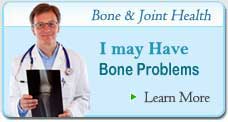» Anti-Aging
» Bones Joints & Muscle Health
- 5 Proven Remedies for Plantar Fasciitis
- Chair Yoga for Seniors: Keys to Maintaining Flexibility
- Restless Leg Syndrome Causing You Pain & Lost Sleep? Learn What IS Known About RLS
- Must Know Lyme Disease Information - You Might Be Surprised To Find Out...
- How To Prevent Falls And Reduce Accidents As We Age
» Cardiovascular Health
» Chronic Pain Management
» Dental Health & Wellness
» Digestive Health Problems
» Health Care
» Mental Health
» Sexual Health
» Skin Care

What To Know About Hip Bursitis and What To Do About It
Hip bursitis is very unpleasant and can cause irritation, pain, mobility problems and worse.
- Bursitis is caused by inflammation of a bursa, a small jelly-like sac that usually contains a small amount of fluid. Bursae are located throughout the body, most importantly around the shoulder, elbow, hip, knee and heel. They act as cushions between bones and overlying soft tissues, and help reduce friction between the gliding muscles and the bone.
The bony point of the hip is called the greater trochanter. It is an attachment point for muscles that move the hip joint. The trochanter has a fairly large bursa overlying it that occasionally becomes irritated, resulting in hip bursitis (trochanteric bursitis).
| Rating | Recommended | Description | Review | ||
|---|---|---|---|---|---|
 |  | Ruby Calcium Osteoporsis Fighting Benefits
| Find Out More | ||
 |  | Vitamin D 2000 Bone Benefits
| Find Out More | ||
 |  | Ageless Select Bone & Joint Benefits
| Find Out More |
Another bursa located on the inside (groin side) of the hip is called the iliopsas bursa. When this bursa becomes inflamed, the condition is also sometimes referred to as hip bursitis, but the pain is located in the groin area.
The condition is not as common as trochanteric bursitis, but is treated in a similar manner.
Most commonly, bursitis is a noninfectious condition (aseptic bursitis) caused by inflammation resulting from local soft tissue trauma or strain injury.
On rare occasions, the hip bursa can become infected with bacteria. This condition is called septic bursitis. Although uncommon, the hip bursa can become inflamed by crystals that deposit there from gout or pseudogout.
Main Symptoms of Hip Bursitis
The main symptoms of hip bursitis is pain at the point of the hip. The pain usually extends to the outside of the thigh area. In the early stages, the pain is usually described as sharp and intense. Later, it may feel more achy and spread out.
Typically, the pain is worse at night, when lying on the affected hip, and when getting up from a chair after being seated for a while. It also may get worse with prolonged walking, stair climbing, or squatting.
Risk Factors
Hip bursitis can affect anyone, but it is more common in women and middle-aged or elderly people. It is less common in younger people and in men.
The following risk factors have been associated with the development of hip bursitis.
- Repetitive stress (overuse) injury. This can occur when running, stair climbing, bicycling, or standing for long periods of time.
- Hip injury. An injury to the point of your hip can occur when you fall on your hip, bump your hip on the edge of a table, or lie on one side of your body for an extended period of time.
- Spine Disease. This includes scoliosis, arthritis of the lumbar (lower) spine, and other spine problems.
- Leg-length inequality. When on leg is shorter than the other by more than an inch or so, it affects the way you walk and can lead to irritation of a hip bursa.
- Rheumatoid arthritis. This makes the bursae more likely to become inflamed.
- Previous surgery. Surgery around the hip or prosthetic implants in the hip can irritate bursae and cause bursitis.
- Bone spurs or calcium deposits. These can develop within the tendons and attach to the trochanter. They can irritate the burs and cause inflammation.
How To Diagnose If You Have Hip Bursitis
To diagnose hip bursitis, the doctor will perform a comprehensive physical examination, looking for tenderness in the area of the point of the hip.
He or she may also perform additional tests to rule out other possible injuries or conditions.
These tests can include radiography (x-rays), bone scanning, and magnetic resonance imaging (MRI).
Treatment
Non Surgical Treatment
The initial treatment for hip bursitis does not involve surgery. Many people with hip bursitis can experience relief with simple lifestyle changes, including:
- Modification of activities-avoiding the activities that worsen symptoms
- Use of non steroidal anti-inflammatory drugs (NSAIDS), such as ibuprofen, naproxen, piroxicam, celcecoxib, and others, to control inflammation and pain
- Use of a walking cane or crutches for a week or more when needed
There is little evidence to support the use of physical therapy to treat hip bursitis, but many patients claim it is helpful. The doctor may ask for a physical therapist to teach you how to stretch your hip and use other treatments such as ice, heat, or ultrasound.
Injection of a corticosteroid with a local anesthetic may also be helpful in relieving symptoms of hip bursitis. This is a simple and effective treatment than can be done in the doctor’s office.
It involves a single injection into the bursa. The injection typically provides permanent relief. If pain and inflammation return, another injection or two, give a few months apart, may be needed.
Use NSAIDS cautiously and for limited periods. Talk to your doctor about the NSAIDS you use. NSAIDs may have adverse side effects if you have medical conditions or take certain medications.
Surgical Treatment
Surgery is rarely needed for hip bursitis. If the bursa remains inflamed and painful after all nonsurgical treatments have been tried, your doctor may recommend surgical removal of the bursa. Removal of the bursa does not hurt the hip, and the hip can actually function normally without it.
A newer technique that is gaining popularity is arthoscopic removal of the bursa. In this technique, the bursa is removed through a small ( 1/4 inch) incision over the hip. A tiny camera, or arthoscope, is placed in a second incision so the doctor can guide the surgical instruments and cut out the bursa. This surgery is much less invasive, and recovery is quicker and less painful.
Both types of surgeries are done on an outpatient (day surgery) basis, so an overnight stay in the hospital is not usually necessary. Early studies show arthroscopic removal of the bursa to be quite effective, but this is still currently being studied.
Rehabilitation
Following surgery, a short rehabilitation period can be expected. Most patients find that using a cane or crutches for a couple of days is helpful. It is reasonable to be up and walking around the evening of the surgery. The soreness from surgery usually goes away after a few days.
How To Prevent Further Inflammation of The Bursa
Prevention is aimed at avoiding behaviors and activities that make inflammation of the bursa worse.
- Avoid repetitive activities that put stress on the hips.
- Lose weight if you need to.
- Get a properly fitting shoe insert for leg-length differences.
- Maintain strength and flexibility of the hip muscles.
You May Also Find Informative:
Aging Fit - Health Research & Information
Better Health. Energy. Quality.






